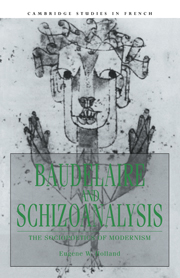5 - Modernist imagination and the “Tableaux Parisiens”
Published online by Cambridge University Press: 22 August 2009
Summary
The “Spleen and Ideal” section ended in “L'Horloge” on a morbid and monotonous note, with the clock God of spleen time counting down the defeated Poet's meaningless minutes and seconds to death; the “Tableaux Parisiens” recontain and defuse the death-threat of spleen time by depicting time as cyclical rather than linear. The very first tableau, “Paysage” (lxxxvi), stages time in the cycle of the seasons, and even puts the seasons themselves in the plural (“Je verrai les printemps, les étés, les automnes” 1. 13), in order to emphasize their cyclical recurrence. “Paysage” also alludes to the cycle of day and night, invoking first the pleasures of “voir naître / L'étoile dans l'azur et la lampe à la fenêtre” (11. 9–10) at dusk, and then that of the ability to “tirer un soleil de mon coeur” during a sleepless night of work. The cyclical alternation of night and day is reinforced by the appearance of “Le Soleil” (lxxxvii) immediately following the nocturnal “Paysage” (in the second edition): as the title suggests, the action in this second poem takes place in the daytime. Indeed, the entire section is structured on the cycle of day and night. “Le Soleil” introduces a diurnal set of poems, comprising roughly the first half of the section, and this group is followed by a nocturnal set of poems, in the second half.
- Type
- Chapter
- Information
- Baudelaire and SchizoanalysisThe Socio-Poetics of Modernism, pp. 137 - 174Publisher: Cambridge University PressPrint publication year: 1993



